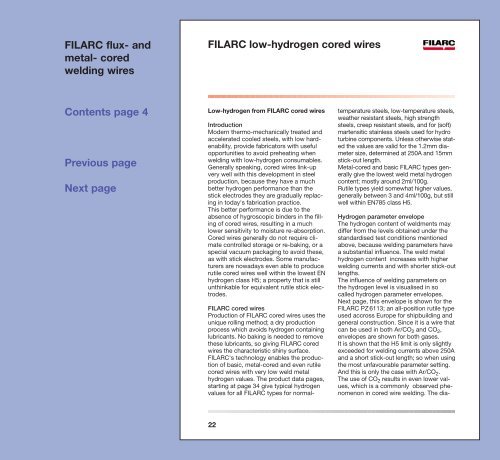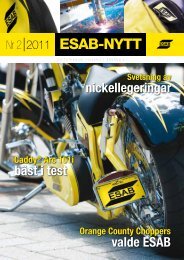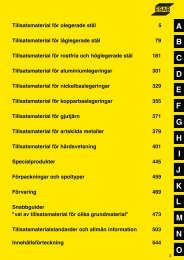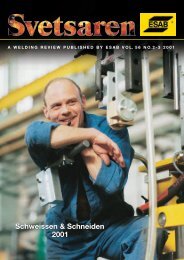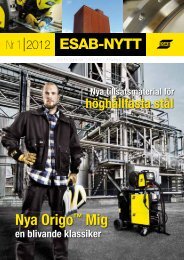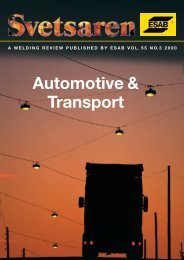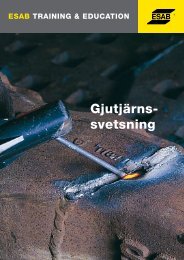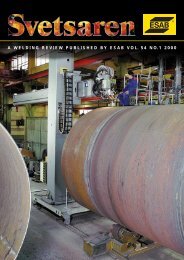FILARC flux - Esab
FILARC flux - Esab
FILARC flux - Esab
- No tags were found...
Create successful ePaper yourself
Turn your PDF publications into a flip-book with our unique Google optimized e-Paper software.
<strong>FILARC</strong> <strong>flux</strong>- andmetal- coredwelding wires<strong>FILARC</strong> low-hydrogen cored wiresContents page 4Previous pageNext pageLow-hydrogen from <strong>FILARC</strong> cored wiresIntroductionModern thermo-mechanically treated andaccelerated cooled steels, with low hardenability,provide fabricators with usefulopportunities to avoid preheating whenwelding with low-hydrogen consumables.Generally speaking, cored wires link-upvery well with this development in steelproduction, because they have a muchbetter hydrogen performance than thestick electrodes they are gradually replacingin today's fabrication practice.This better performance is due to theabsence of hygroscopic binders in the fillingof cored wires, resulting in a muchlower sensitivity to moisture re-absorption.Cored wires generally do not require climatecontrolled storage or re-baking, or aspecial vacuum packaging to avoid these,as with stick electrodes. Some manufacturersare nowadays even able to producerutile cored wires well within the lowest ENhydrogen class H5; a property that is stillunthinkable for equivalent rutile stick electrodes.<strong>FILARC</strong> cored wiresProduction of <strong>FILARC</strong> cored wires uses theunique rolling method; a dry productionprocess which avoids hydrogen containinglubricants. No baking is needed to removethese lubricants, so giving <strong>FILARC</strong> coredwires the characteristic shiny surface.<strong>FILARC</strong>'s technology enables the productionof basic, metal-cored and even rutilecored wires with very low weld metalhydrogen values. The product data pages,starting at page 34 give typical hydrogenvalues for all <strong>FILARC</strong> types for normaltemperaturesteels, low-temperature steels,weather resistant steels, high strengthsteels, creep resistant steels, and for (soft)martensitic stainless steels used for hydroturbine components. Unless otherwise statedthe values are valid for the 1.2mm diametersize, determined at 250A and 15mmstick-out length.Metal-cored and basic <strong>FILARC</strong> types generallygive the lowest weld metal hydrogencontent; mostly around 2ml/100g.Rutile types yield somewhat higher values,generally between 3 and 4ml/100g, but stillwell within EN785 class H5.Hydrogen parameter envelopeThe hydrogen content of weldments maydiffer from the levels obtained under thestandardised test conditions mentionedabove, because welding parameters havea substantial influence. The weld metalhydrogen content increases with higherwelding currents and with shorter stick-outlengths.The influence of welding parameters onthe hydrogen level is visualised in socalled hydrogen parameter envelopes.Next page, this envelope is shown for the<strong>FILARC</strong> PZ 6113; an all-position rutile typeused accross Europe for shipbuilding andgeneral construction. Since it is a wire thatcan be used in both Ar/CO 2 and CO 2 ,envelopes are shown for both gases.It is shown that the H5 limit is only slightlyexceeded for welding currents above 250Aand a short stick-out length; so when usingthe most unfavourable parameter setting.And this is only the case with Ar/CO 2 .The use of CO 2 results in even lower values,which is a commonly observed phenomenonin cored wire welding. The dia-22


